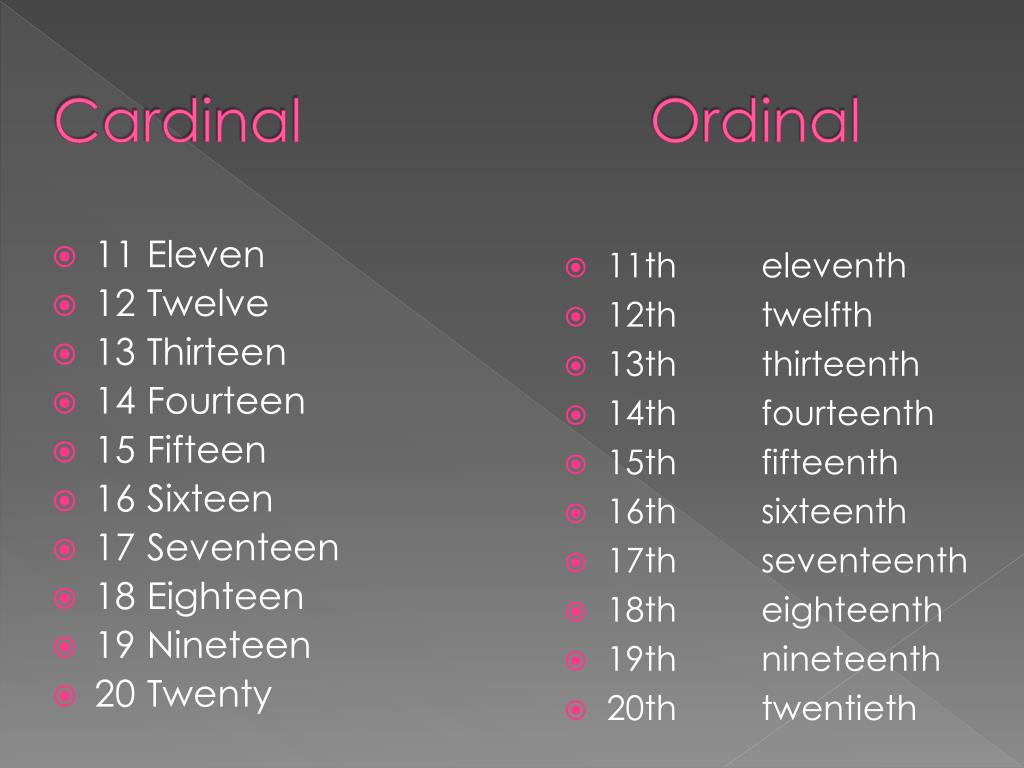
PPT Numbers Ordinal and Cardinal PowerPoint Presentation, free
Cardinal and Ordinal Numbers Chart. A Cardinal Number is a number that says how many of something there are, such as one, two, three, four, five. An Ordinal Number is a number that tells the position of something in a list, such as 1st, 2nd, 3rd, 4th, 5th etc. Most ordinal numbers end in "th" except when the final word is: one → first (1st.

Ordinal Numbers Definition, List from 1 to 100, Chart, Examples
Cardinal numbers, known as the "counting numbers," indicate quantity. Ordinal numbers indicate the order or rank of things in a set (e.g., sixth in line; fourth place). Nominal numbers name or identify something (e.g., a zip code or a player on a team.) They do not show quantity or rank.
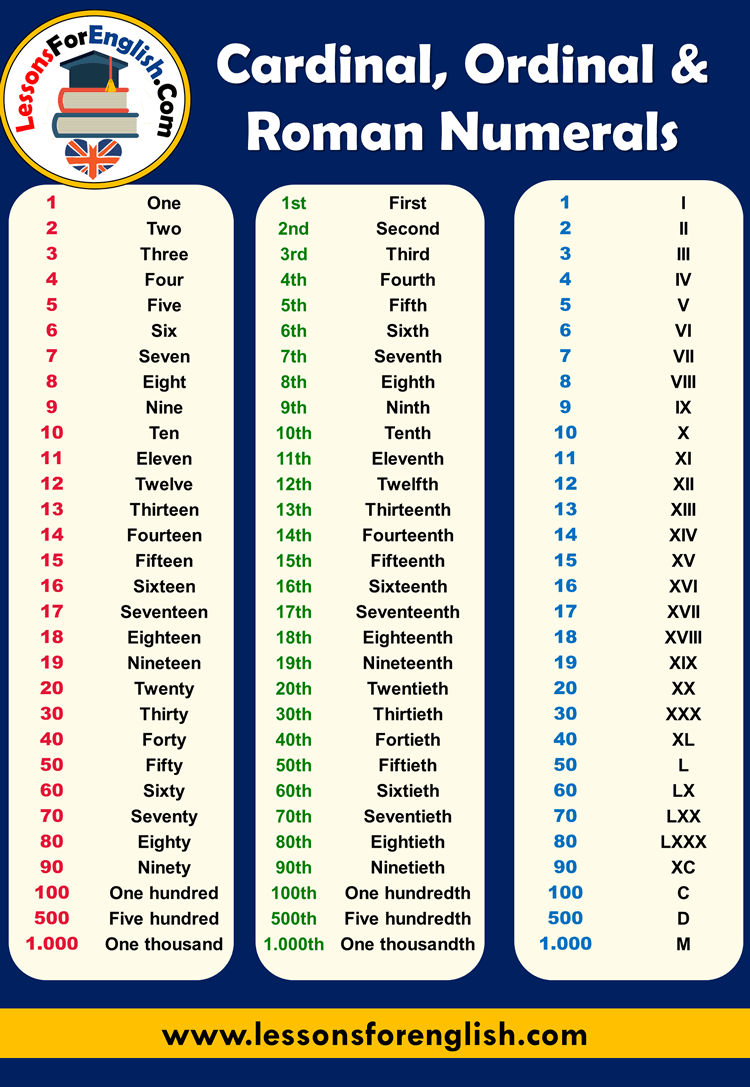
Cardinal, Ordinal and Roman Numerals Lessons For English
Initial ordinal of a cardinal. Each ordinal associates with one cardinal, its cardinality. If there is a bijection between two ordinals (e.g. ω = 1 + ω and ω + 1 > ω), then they associate with the same cardinal. Any well-ordered set having an ordinal as its order-type has the same cardinality as that ordinal.
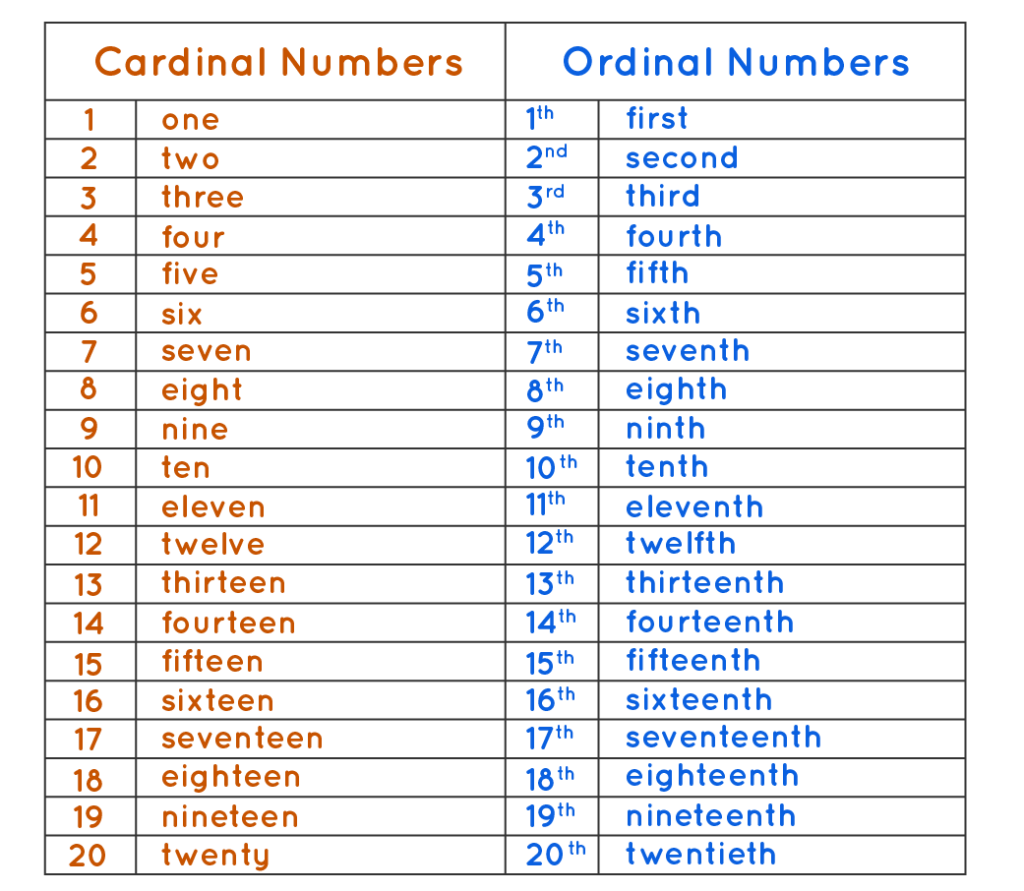
Ordinal Numbers Definition, Facts, Examples Ordinal Numbers Chart 1
A Few Example Sentences using Cardinal Numbers. 1. We have only five glasses. 2. Tomorrow is my sister's birthday. She will turn 18. 3. You have asked to bring 100 colorful balloons. 4. Girl at the number 14 is amazing and very talented. 5. Let me introduce these four volunteers. Ordinal Numbers. An ordinal number is used as a

Perbedaan Cardinal dan Ordinal Numbers Zenius Blog
Ordinal numbers are the numbers such as first (1 st ), second (2 nd ), third (3 rd ), fourth (4 th ), fifth (5 th ), sixth (6 th ), seventh (7 th) and so on. While cardinal numbers are the ones that tell us how many of something there is, ordinal numbers are the numbers that tell us the position of something rather than the quantity.

EduBlog EFL Cardinal and ordinal numbers.
This rule helps in understanding how to form ordinal numbers from their cardinal counterparts, especially for numbers in the twenties and beyond. 20 (twenty) → 20th (twentieth) 23 (twenty-three) → 23rd (twenty-third) 156 (one hundred fifty-six) → 156th (one hundred fifty-sixth) This conversion rule is a handy guideline for correctly.
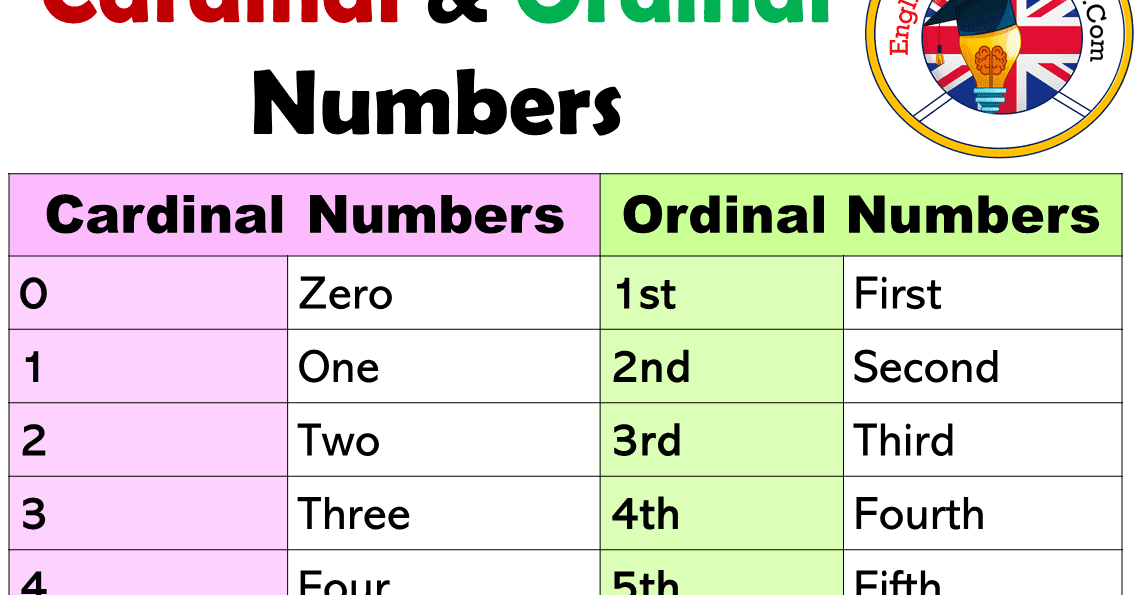
Miriam's Magic Backpack CARDINAL & ORDINAL NUMBERS
Von Neumann cardinal assignment implies that the cardinal number of a finite set is the common ordinal number of all possible well-orderings of that set, and cardinal and ordinal arithmetic (addition, multiplication, power, proper subtraction) then give the same answers for finite numbers. However, they differ for infinite numbers.

Cardinal & Ordinal Numbers English Study Here
All the natural numbers are also referred to as cardinal numbers. Cardinal numbers are used for counting. While an ordinal number is a number that denotes the position or place of an object. Example: 1 st, 2 nd, 3 rd, 4 th, 5 th, etc. Ordinal numbers are used for ranking.Here is an example that explains cardinal and ordinal numbers:
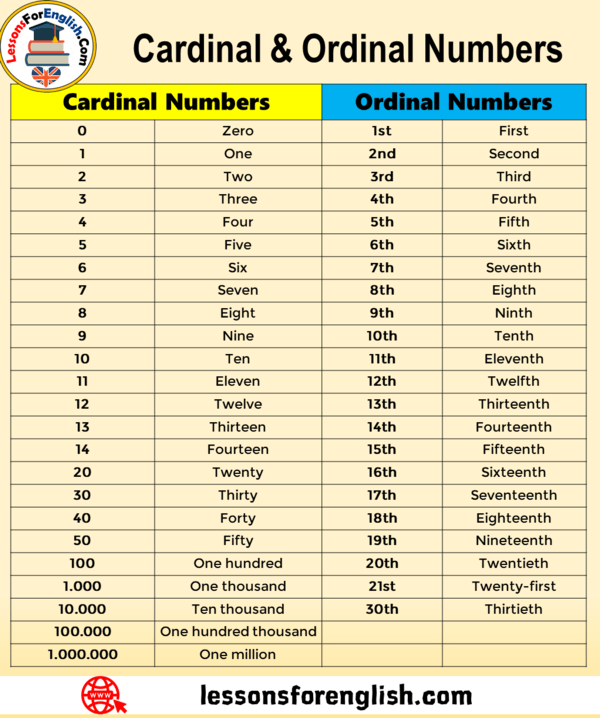
Cardinal & Ordinal Numbers in English Lessons For English
Cardinal numbers signify quantity. Ordinal numbers signify order or position. Math and writing are difficult to mix well, but if you remember that ordinal numbers represent order, you will be well on your way to writing coherently about different kinds of numbers. In summary, ordinal means order, while cardinal means quantity.
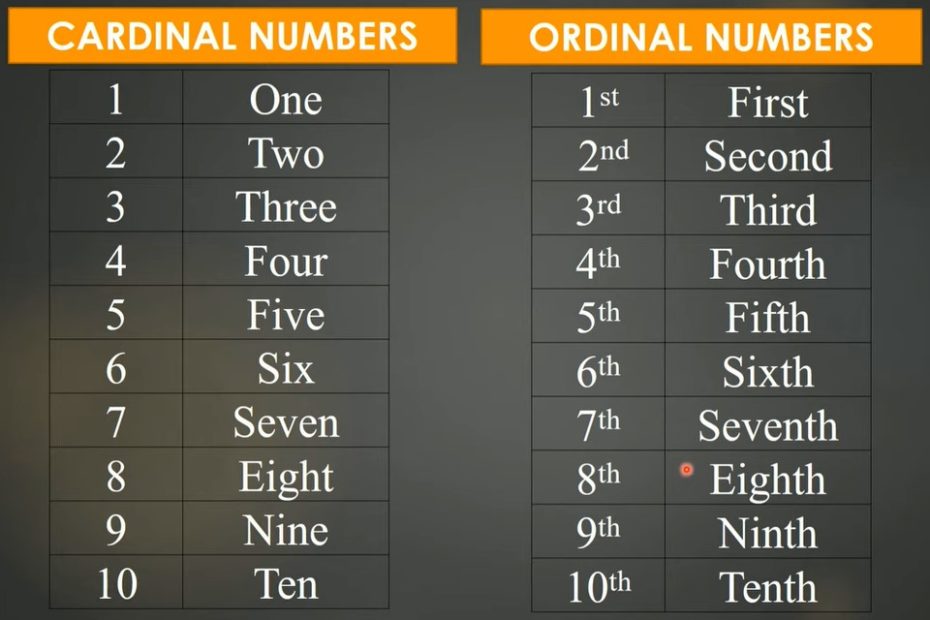
Diference of Cardinal and Ordinal Numbers Sinaumedia
Cardinal Numbers vs. Ordinal Numbers. As we discussed, the cardinal numbers are used for counting. They include all the natural numbers. However, an ordinal number is a number that is used to represent the position or order of an object. Examples: 1 st rank, 2 nd in a queue, 3 rd row, tenth floor, etc. Ordinal numbers are used for ranking or.
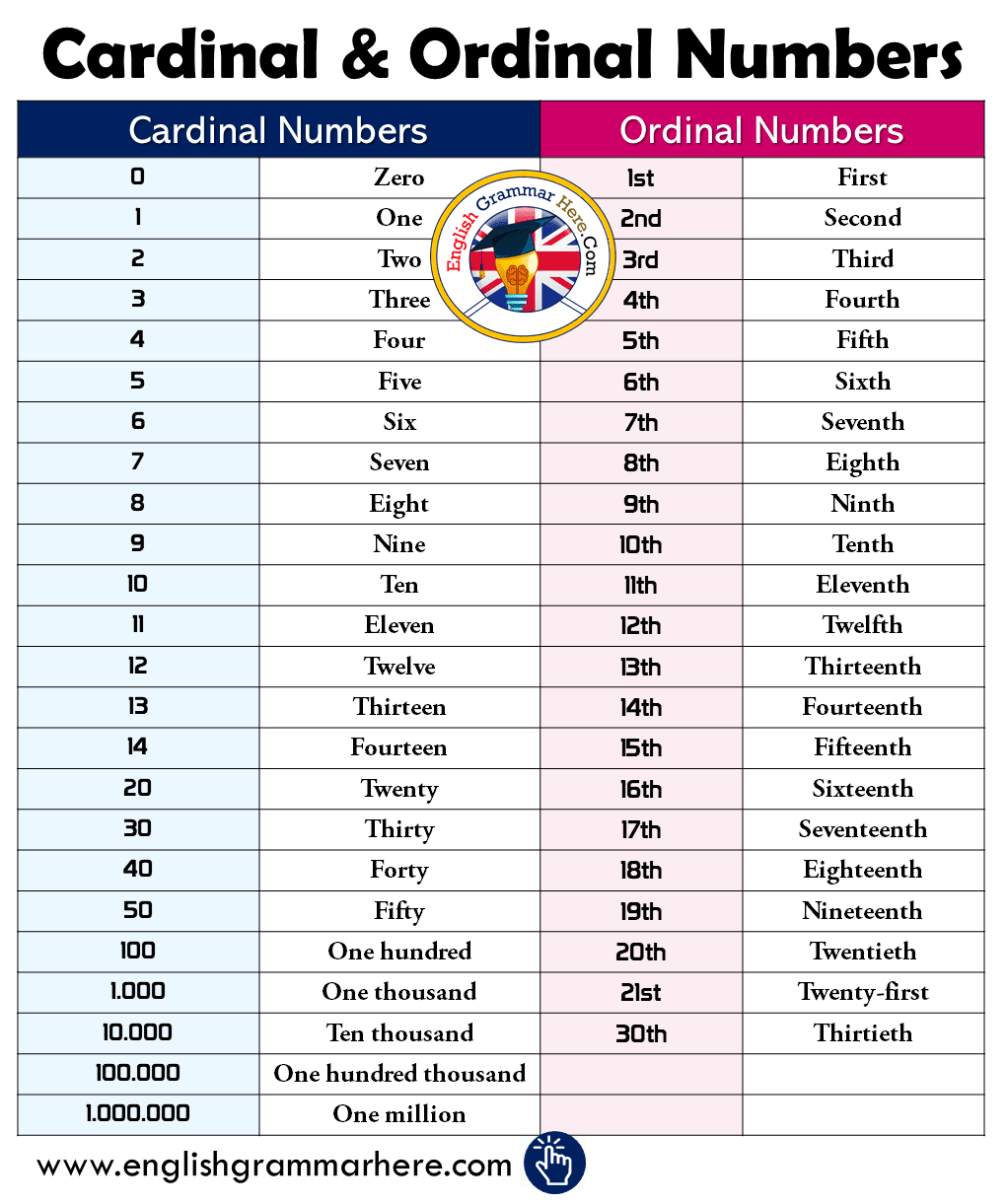
The Cardinal and Ordinal Numbers.
Cardinal numbers and ordinal numbers are both used in everyday life situations. Both concepts are taught alongside each other and usually not explicitly differentiated. to position or order events such as who came first in a race (ordinal). In Year 1 children will continue to use cardinal and ordinal numbers 0-20.

Cardinal and Ordinal Numbers Comparison Chart Ordinal numbers, Number
Summary: Cardinal and Ordinal Numbers. We can sum up cardinal and ordinal numbers as follows: We use cardinal numbers to count (e.g. one, two, three). Typically, in formal writing, you will need to write out numbers up to ten as words and use numerals for larger values. We use ordinal numbers to rank or order things (e.g. first, second, third).

Cardinal and Ordinal number chart English ESL worksheets pdf & doc
Define ordinal numbers: ordinal numbers are numbers denoting an item's place in a series. In summary, Cardinal numbers are numbers that represent how many of something someone has. These are numbers like one, two, three, and four. Ordinal numbers are numbers that represent place or position. These are numbers like first, second, third, and.

Cardinal and Ordinal Numbers Classroom101
Cardinal Daniel DiNardo, then the conference vice president, replied brusquely to McElroy, commenting on the latter's "rhetorical flourishes" as if rhetoric was the heart of the matter. It was.

Cardinal And Ordinal Numbers Chart
Distinguishing Cardinal and Ordinal Numbers: To show the contrast, consider a line of students waiting for a school bus. If you want to know how many students are in the line, you would use a cardinal number: "There are 15 students in the line." If you want to specify the position of a particular student, you would use an ordinal number.

Cardinal Numbers and Ordinal Numbers in English English Study Here
Ordinal is a subjective measurement of utility, thus more practical and sensible. Cardinal utility is represented with numbers ending 1-one, 2- two, 3 - three etc. Ordinal utility is essentially represented with numbers ending with 1 '-st', 2 '-nd' and 3 '-rd'. Measurement of utility is done on the basis of utilities.